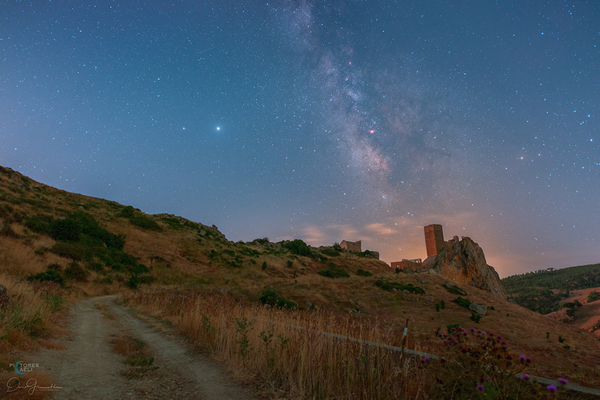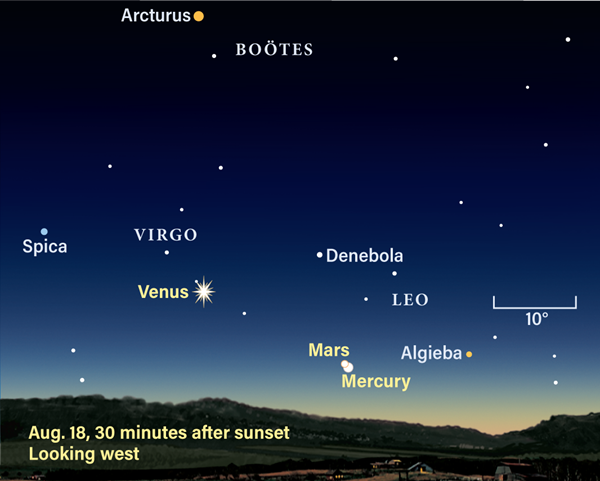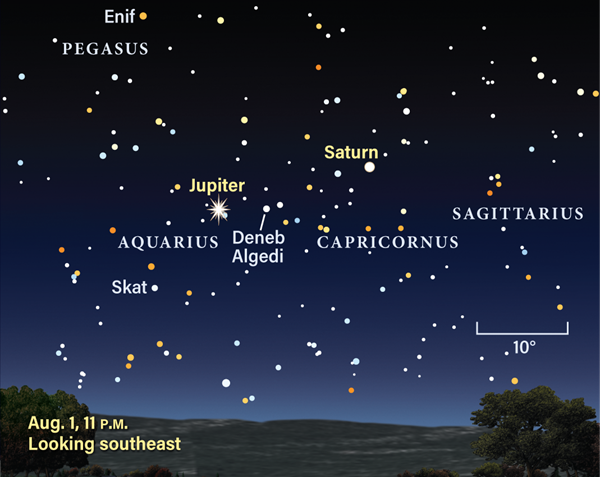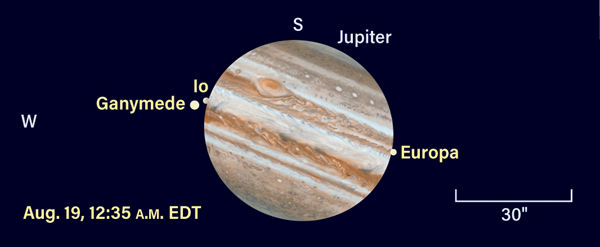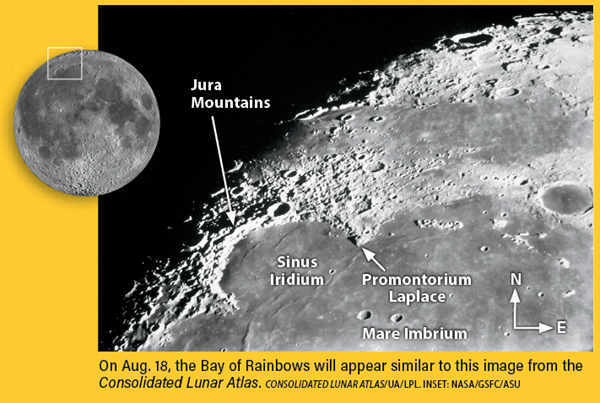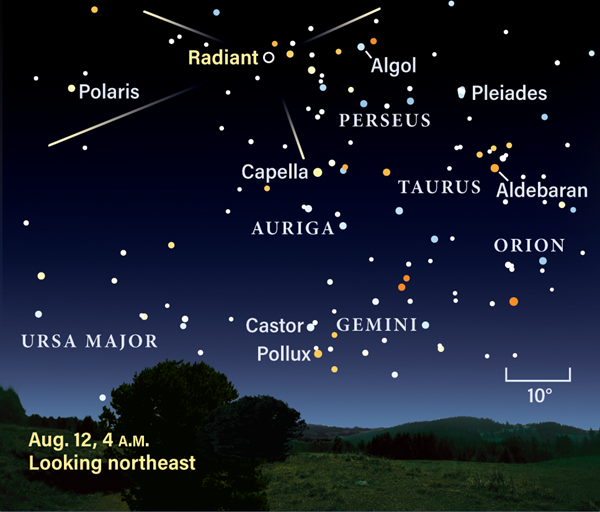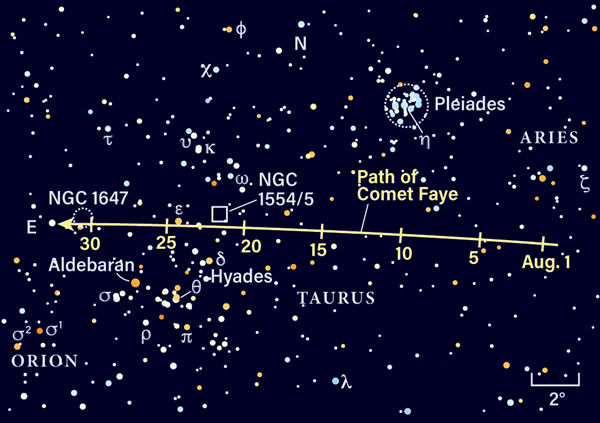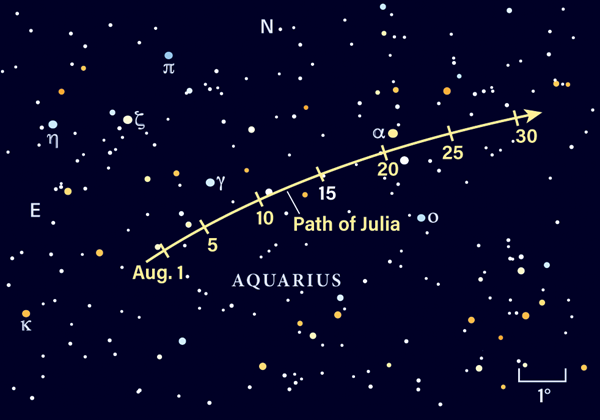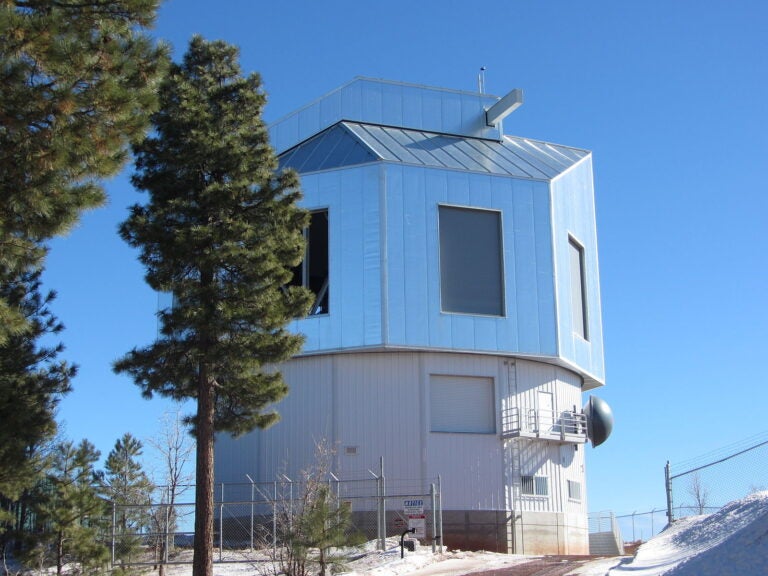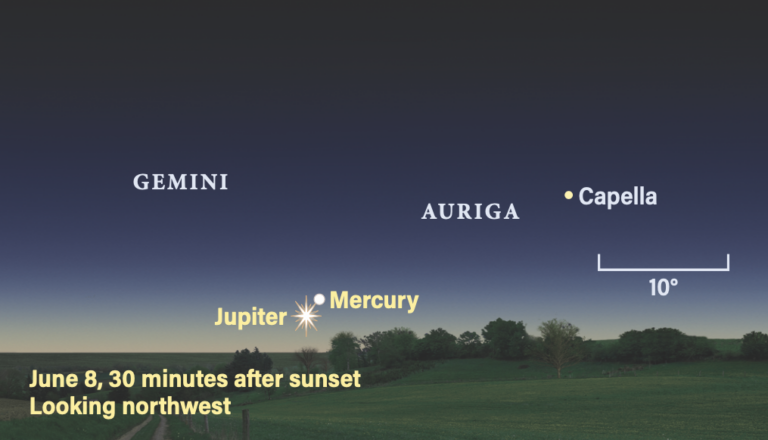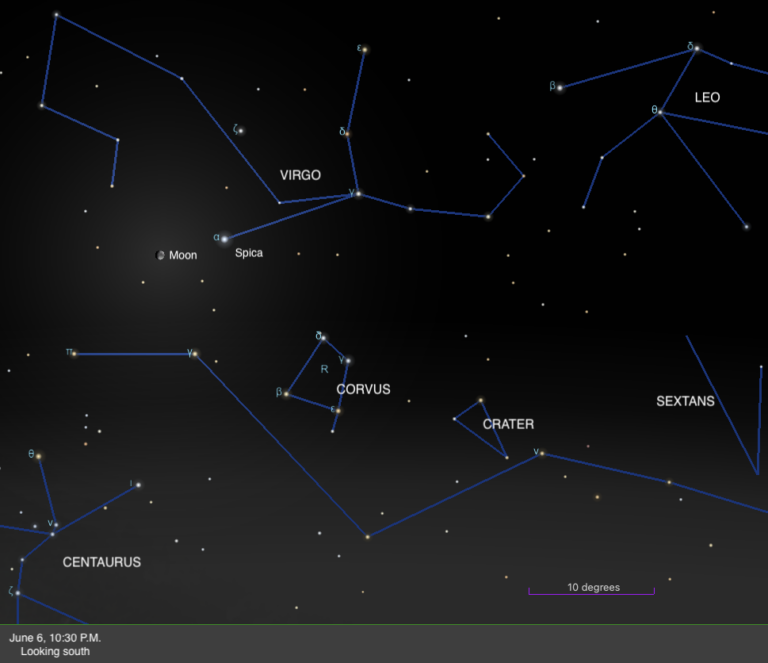On early August evenings, you’ll find three rocky planets in the sky: Venus, Mars, and Mercury. Venus is easy to spot, so use it as a guide to find the other two, which are more challenging in twilight. Overnight there’s a planet spectacular starring Saturn and Jupiter, both of which reach opposition this month. Jupiter provides some unique satellite events not to be missed if you have a telescope. Binocular viewers can track down distant giants Uranus and Neptune in the morning sky.
Brilliant Venus dominates the western sky this month. It glows at magnitude –3.9 in early August and is 8° high in the west 45 minutes after sunset, easy to spot as twilight descends. The planet roughly maintains this position as it slides along the ecliptic through Leo and Virgo, moving southwest. Venus crosses the celestial equator by Aug. 17 and continues to more southerly declinations. While its elongation from the Sun increases from 33° to 40° this month, the planet doesn’t gain altitude for Northern Hemisphere observers.
On Aug. 10, a thin three-day old crescent Moon pairs elegantly with Venus. Note the earthshine illuminating the dark portion of our satellite. Set against the deep blue twilight, this is a memorable scene. By Aug. 13, Venus appears to have a moon of its own: 4th-magnitude Beta (β) Virginis is located just 8′ to its southwest. Use binoculars to pick up the dim star. By August’s end, Venus and Virgo’s brightest star, Spica, hang low in the west, less than 7° apart. Venus, now magnitude –4, outshines 1st-magnitude Spica.
Venus’ sheer brilliance makes details more difficult to view when the sky is dark. Try very early in twilight or even before sunset (never point your telescope toward the Sun). Venus is 82 percent lit and 13″ wide on Aug. 1. By month’s end, the phase shrinks to 73 percent lit and the planet spans 15″.
Much dimmer magnitude 1.8 Mars is located 11° west (lower right) of Venus on Aug. 1. Mars also stands 2° from magnitude 1.4 Regulus. Both are a challenging 5° high in the west 30 minutes after sunset. Try using binoculars to spot them; you’ll need a clear horizon. They set about an hour after the Sun.
Mars is a few months away from solar conjunction and gradually becoming more difficult to observe. Over the next few days, Regulus quickly drops out of view and the Red Planet slides eastward across Leo. Your last view of Mars could be Aug. 9, when a slender two-day-old Moon is visible for about an hour after sunset, with Mars 3.5° to its south.
Mercury makes a brief, low appearance this month. Following superior conjunction Aug. 1, it moves into the evening sky, nestled in twilight. Lucky observers with a clear western horizon may catch it Aug. 9 — the same day the Moon and Mars are close. Mercury lies 9° west of the Moon and sets 30 minutes after the Sun. At magnitude –1.1, you may catch it in binoculars 15 minutes after sunset, now 2° above the horizon.
Mercury extends its separation from the Sun each day, but for Northern Hemisphere observers, it doesn’t gain altitude. It also slowly fades. Try to catch Mercury and Mars in an extremely close conjunction Aug. 18. Twenty minutes after sunset, Mercury stands 4° high and shines at magnitude –0.6. Mars stands 7′ east of Mercury. Dim Mars is tough to spot, but follow Mercury as the sky darkens for a glimpse of the Red Planet. Mercury remains low and dims to magnitude 0 at the end of August, when it stands 3.5° high in the west 30 minutes after sunset.
Saturn reaches opposition at 2 A.M. EDT Aug. 2. Rising in the southeast as the Sun sets, you’ll find the ringed planet 15° high by 10 P.M. local time. It reaches 30° altitude by Aug. 31 at the same time. Saturn is easy to spot among the faint stars of Capricornus the Sea Goat, outshining everything in this region. The planet starts August at magnitude 0 but quickly dims to 0.2 for the rest of the month.
Like all outer planets, Saturn is best viewed near the meridian; at opposition, this is around local midnight (1 A.M. for locations using daylight time). Any backyard telescope will reveal its 19″-wide disk, encircled by the magnificent ring system spanning 42″ by 13″. Details of Saturn’s subtle atmospheric belts are best seen by allowing your eyes to catch fleeting periods of good seeing. Saturn’s polar diameter spans 17″ and the rings’ diminishing angle to our line of sight (now 18°) reveals the south polar region.
Saturn’s brightest moon, Titan, orbits every few weeks. You’ll find it north of the planet Aug. 3 and 19, and south of the planet Aug. 11 and 26/27.
Tenth-magnitude Tethys, Dione, and Rhea hover closer to the rings, changing relative positions hourly. Fainter magnitude 12 Enceladus orbits a few arcseconds from the rings’ bright edge. On Aug. 2, this moon appears to gain a twin when a field star of similar brightness lies close to it on the east side of the rings. Just a few minutes of observation between sunset and local midnight will show their relative positions changing. The moon and star appear closest (3″ apart) around midnight EDT on the 2nd. If you miss it, try again Aug. 8, when another field star passes 12″ south of the moon.
Iapetus reaches eastern elongation nearly 9′ due east of Saturn on Aug. 12, shining close to magnitude 12. It then moves back toward Saturn, brightening by 1 magnitude and reaching inferior conjunction 50″ from Saturn on Aug. 31.
Jupiter rises an hour after Saturn and reaches opposition Aug. 19. Located in southern Aquarius, Jupiter glows a brilliant magnitude –2.8 Aug. 1 and brightens to –2.9 by midmonth. Its retrograde track carries it into Capricornus on Aug. 18. You’ll find Jupiter 5° north of the Full Moon on Aug. 21.
Jupiter is a wonderful object through a telescope. Its disk spans its widest for the year at 49″ and the planet lies 4 astronomical units (AU) from Earth (1 AU is the average Earth-Sun distance). Any telescope will reveal fine details in its atmosphere, which is best seen when the planet is near your local meridian in the hour after midnight. Jupiter stands 36° high at 1 A.M. local time; it is somewhat higher for observers in southern states and lower for those in northern ones.
It’s the best time of the year to see the two dark belts straddling the equator, as well as the associated plumes and festoons of more gently shaded features. These sights move quickly with Jupiter’s rotation period, which ranges from 9 hours 50 minutes to 9 hours 55 minutes.
Galilean moons Io, Europa, Ganymede and Callisto are easy to track in small scopes. Io swaps sides — from east to west — night after night. The others do the same over longer periods. Larger scopes (8 inches or more) may reveal the disks of Ganymede and Callisto around opposition if seeing conditions permit. They span 1.8″ and 1.7″, respectively.
Special this year are mutual events of the satellites themselves, where one moon eclipses or occults another. This occurs when their orbital planes align exactly with our line of sight. Four events are visible from the continental U.S.: two overnight on Aug. 8/9, one early on Aug. 16, and one final event overnight on Aug. 18/19. Under typical seeing conditions, most observers will detect a blending of two moons during an occultation or a dimming of one moon during an eclipse. Visit www.Astronomy.com/skythisweek for details on each event. There are many other transits and occultations of individual moons with Jupiter throughout the month.
Neptune rises two hours after sunset in early August, and is 20° high in the east by local midnight. It glows at magnitude 7.7 — within reach of binoculars and appearing as a dim star. You’ll find it just over 5° east of 4th-magnitude Phi (ϕ) Aquarii and due south of the Circlet in Pisces. A telescope under high power and good seeing conditions reveals its bluish 2″-wide disk. On Aug. 25, Neptune sits midway between two brighter (magnitude 6.5 and 6.9) field stars. During August, Neptune drifts westward (retrograde), moving closer to Phi. It reaches opposition next month.
Uranus lies in a dim part of southern Aries, rising soon after local midnight on Aug. 1 and beginning its retrograde motion after reaching its stationary point at midnight EDT Aug. 19. The planet is best viewed in the hours before dawn. Uranus hasn’t been this far north (declination 16°) for nearly 60 years. It’s an easy binocular object at magnitude 5.8. Look for it as the apex of an equilateral triangle with Omicron (ο) and Sigma (σ) Arietis — magnitude 5.8 and 5.5, respectively — forming the base. A telescope will reveal Uranus’ planetary status as a 4″-wide greenish-blue disk, distinctly not starlike. Uranus stands 5° east of the waning Moon half an hour before sunrise Aug. 1. The Moon returns to the vicinity Aug. 28. This time, Uranus stands 1.8° northwest of our satellite half an hour before sunrise, with Sigma Ari less than 1° from the Moon’s northern limb.
Rising Moon: A view of the bay
Prominently located in the northwest quadrant of the lunar face is the Bay of Rainbows, Sinus Iridum. And what a sight on the evening of the 17th: A striking semicircular arc of mountains greets the Sun!
The leading peak, Promontorium (Cape) Laplace, casts a long shadow across the undulating lavas of the bay. Watch it shorten over a few hours as the Sun continues to rise, painting its light slowly down the flanks of the westernmost peaks.
The highest points on the dark side of the terminator will flicker in and out, changing color in the same way Sirius twinkles due to Earth’s atmospheric turbulence. Perhaps this is why it was named the Bay of Rainbows.
Well defined by their shadows on the 17th, the long wrinkle ridges stretching south disappear by the 19th under a higher Sun. The Jura Mountains that form the arc of Iridum separate the bright highland material to the north from the darker Mare Imbrium to the south.
It was here eight years ago that China landed their Yutu (Jade Rabbit) rover. Scientists deduced that the surface in this region is indeed volcanic basalt representative of the Moon’s upper mantle, a full billion years younger than the 4-billion-year-old samples returned by Apollo astronauts.
Meteor Watch: Morning show
One of the Year’s best showers, the Perseids, occurs in August. This year, conditions are very favorable with no Moon after midnight. The Perseids peak Aug. 12 during the day for U.S. observers; the mornings of the 12th and 13th should provide good rates. If your weather is poor, try the 10th and 11th as well.
On Aug. 12, a four-day-old Moon sets soon after 10:30 P.M. local time, offering ideal dark sky conditions for meteor observing. The radiant in Perseus rises to around 60° in the hour before dawn, attenuating the listed zenithal hourly rate (which occurs when the radiant is at 90° elevation) of 110 meteors per hour by about 15 percent. This converts to an average of one meteor per minute in the predawn hours.
Perseid meteors are the result of debris left by Comet 109P/Swift-Tuttle. The shower was widely known by the 1830s but certainly had been active before that date.
Comet Search: Star-studded path
The closer on a short summer’s night should be Comet 4P/Faye. A 6-inch scope under country skies will pick up the 10th-magnitude fuzz approaching the midpoint of the Pleiades and Hyades star clusters in Taurus.
You may not see it at first with low power, so try about 100x. The stubby, ill-defined tail drifts out of the eyepiece, followed by the sharper flank, which faces the solar wind. Compare it to globular star cluster M72 in Aquarius.
Barely a couple of miles wide, Faye hadn’t yet been recovered in early April, when its distance was 2.2 AU. By contrast, Comet C/2017 K2 — expected to rank in the top three comets for the entirety of 2022–2023 — was discovered four years ago when it was still out at 16 AU.
Hervé Faye first saw 4P in 1843, when suburban Paris had few lights at night. Returning every 7.6 years, the comet won’t give us another good look until 2036.
Locating Asteroids: Go with the flow
Above the blazing beacon of Jupiter (to the planet’s northeast), our eyes alight on a tight grouping of 4th-magnitude stars nicknamed the Water Jar asterism. In larger cities, you may need binoculars to pick it up, with 3rd-magnitude Alpha (α) Aquarii leading the pack. Together they form a recognizable backdrop that helps us home in on our target.
Reaching a peak brightness of magnitude 8.9 on its opposition date, Aug. 24, 89 Julia will require a 60mm scope at 80x to spy it. Thankfully, we are far from the profusion of Milky Way stars in the background that might overwhelm us. Nights to note are the 3rd and 4th, as well as the 19th and 20th; these pairs of nights are when the anchoring field stars allow you to see Julia’s small shift at the bookends of a two-hour observing session. Avoid the nights of Aug. 21 and 22, when the Moon’s bright glare is nearby.
Plying the main belt between Mars and Jupiter, this small world was named after Saint Julia. Édouard Stephan, who discovered the marvelous galaxy group we continue to call Stephan’s Quintet, first spotted the asteroid in August 1866.

